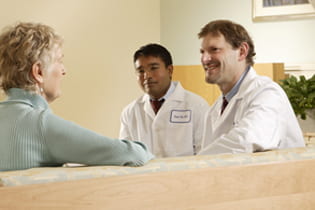Improved treatment for stroke
UC Irvine Medical Center’s Dr. Steven Cramer works successfully behind the scenes to improve stroke treatment for Orange County residents.

Each year, nearly 8,000 Orange County residents have a stroke. Too often, symptoms go unrecognized, delaying measures that could save lives and greatly reduce long-term disability.
“Studies show that immediate treatment in the early stages of a stroke can significantly improve outcomes for patients,” says Dr. Steven C. Cramer, director of UC Irvine’s Stroke & Cerebrovascular Center. “The key is to have a system in place to quickly recognize stroke symptoms, properly triage patients and then deliver them to a hospital that is prepared to rapidly assess their condition and begin treatment.”
Creating such a system has long been Cramer’s goal. More than four years ago, he and the center’s stroke program manager, Dana Stradling, R.N., began promoting the concept among neurologists, neurosurgeons, emergency-medicine physicians, hospital CEOs and others.
In April the county’s Health Care Agency designated UC Irvine Medical Center in Orange a Stroke-Neurology Receiving Center. It joins five other such sites offering high-level neurovascular care to which paramedics and ambulance drivers take stroke cases.
“This is an enormous step forward for the health of Orange County’s residents,” Cramer says. Stroke occurs when a blood vessel in the brain bursts or is blocked by a blood clot. It is the third-leading cause of death in the U.S. and is often behind serious, long-term disability.
Not all hospitals have the resources or personnel to effectively treat a stroke. The county requires that a Stroke-Neurology Receiving Center have a dedicated medical director, an emergency-medicine physician on-site at all times, and a neurologist, neurosurgeon and radiologist always on call.
UC Irvine Medical Center also has an interventional neuroradiologist available around the clock capable of extracting a stroke-inducing blood clot by inserting a catheter into a patient’s arteries.
Another advance in stroke treatment is the clot-busting drug tPA – tissue plasminogen activator. But it must be administered within three hours of the onset of symptoms to avoid permanent brain damage. Only about 3 percent of U.S. stroke patients reach a hospital quickly enough to be considered for this treatment. The Stroke-Neurology Receiving Center system promises to improve those chances.
Orange County was the first in Southern California to establish such a system, joining several other California counties, such as Santa Clara and San Francisco, and states such as New York.
On May 19, Orange County’s Emergency Medical Services honored Cramer with its Vision in EMS Award for spearheading the program’s creation. Dr. Samuel J. Stratton, EMS medical director, said that not long ago emergency services could only diagnose a stroke and tell the patient’s family “to hope for the best.”
“Now in Orange County medics recognize the signs of stroke and take the patient to a Stroke-Neurology Receiving Center, where an entire team will provide care, like a trauma team,” Stratton said. “We owe Dr. Cramer an incredible amount of gratitude.”